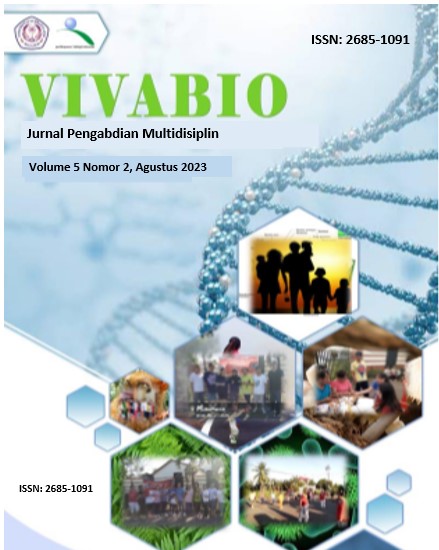Peningkatan Kewaspadaan Warga Terhadap Banjir Melalui Penerapan Alat Pemantau Ketinggian Air di Aliran Sungai Kalijompo Kabupaten Jember
DOI:
https://doi.org/10.35799/vivabio.v5i2.46349Abstract
Flooding is a natural phenomenon that occurs as a result of high rainfall resulting in excess water that is not accommodated by the system. In general, the impact of floods can be detrimental to the community, especially people who live on the outskirts of the river. Jember Regency is one of the regencies that has many rivers that have the potential to not be able to accommodate water in the rainy season, resulting in flooding, one of which is the Kalijompo River, which floods almost every year. The impact of flooding can be minimized with good development and an early warning system for residents. Technology is one way to make human work easier, one of which is to monitor a situation. The application of river flow monitoring technology can reduce the detrimental impact of flooding. This technology provides information to residents about water levels. The technology applied has sensors that can monitor the height of the river flow, the height of the river flow consists of four levels, namely normal to dangerous which is marked by an alarm sound, so that when a flood occurs at night residents can get up immediately to save themselves, then the detrimental impact of flooding can be reduced.
References
Arifin, R. W. (2016). Pemanfaatan Teknologi Informasi Dalam Penanggulangan Bencana Alam Di Indonesia Berbasiskan Web. BINA INSANI ICT Journal, 1-6.
Awaliyah, N., Sarjanti, E., & Suwarno. (2014). Pengetahuan Masyarakat Dalam Mitigasi Bencana Banjir di Desa Penolih Kecamatan Kaligondang Kabupaten Purbalingga. Geoedukasi, 92-95.
Aziza, S. N., Wahyuningsih, S., & Novita, E. (2018). Beban Pencemaran Kali Jompo Di Kecamatan Patrang-Kaliwates Kabupaten Jember. Jurnal Agroteknologi, 100-106.
Budiarti, W., Gravitiani, E., & Mujiyo. (2017). Upaya Mitigasi Banjir di Sub DAS Samin Melalui Pengembangan Masyarakat Tangguh Bencana. Jurnal Teknologi Lingkungan, 241-250.
Emaliyawati, E., Prawesti, A., Yosep, I., & Ibrahim, K. (2016). Manajemen Mitigasi Bencana dengan Teknologi Informasi di Kabupaten Ciamis. Jurnal Keperawatan Padjadjaran, 79-88.
Koem, S., Akase, N., & Muis, I. (2019). Peningkatan Kapasitas Masyarakat Dalam Mengurangi Risiko Bencana di Desa Bandung Rejo Kabupaten Gorontalo. Aksiologiya: Jurnal Pengabdian Kepada Masyarakat, 176-184.
Paimin, Sukresno, & Pramono, I. B. (2009). TEKNIK MITIGASI Banjir dan Tanah Longsor. Bogor: Tropenbos International Indonesia Programme.
Pratama, N., Darusalam, U., & Nathasia, N. D. (2020). Perancangan Sistem Monitoring Ketinggian Air Sebagai Pendeteksi Banjir Berbasis IoT Menggunakan Sensor Ultrasonik. JURNAL MEDIA INFORMATIKA BUDIDARMA, 117-123.
Rosyidie, A. (2013). Banjir: Fakta dan Dampaknya, Serta Pengaruh dari Perubahan Guna Lahan. Jurnal Perencanaan Wilayah dan Kota, 241-249.
Santri, Apriyanto, E., & Utama, S. P. (2020). Dampak Sosial Ekonomi Dan Estimasi Kerugian Ekonomi Akibat Banjir Di Kelurahan Rawa Makmur Kota Bengkulu. Naturalis, 77-84.
Sebastian, L. (2008). Pendekatan Pencegahan Dan Penanggulangan Banjir. Dinamika Teknik Sipil, 162-169.
Wiratama, N. A., Wiharta, D. M., & Wirastuti, N. M. (2020). Rancang Bangun Sistem Monitoring Ketinggian Air Berbasis Android Menggunakan Transistor Water Level Sensor. Spektrum, 81-89.
Downloads
Published
How to Cite
Issue
Section
License
Copyright (c) 2023 Authors

This work is licensed under a Creative Commons Attribution-ShareAlike 4.0 International License.



